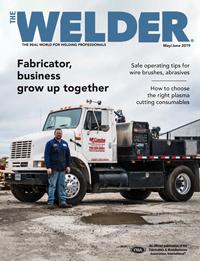President
- FMA
- The Fabricator
- FABTECH
- Canadian Metalworking
Categories
- Additive Manufacturing
- Aluminum Welding
- Arc Welding
- Assembly and Joining
- Automation and Robotics
- Bending and Forming
- Consumables
- Cutting and Weld Prep
- Electric Vehicles
- En Español
- Finishing
- Hydroforming
- Laser Cutting
- Laser Welding
- Machining
- Manufacturing Software
- Materials Handling
- Metals/Materials
- Oxyfuel Cutting
- Plasma Cutting
- Power Tools
- Punching and Other Holemaking
- Roll Forming
- Safety
- Sawing
- Shearing
- Shop Management
- Testing and Measuring
- Tube and Pipe Fabrication
- Tube and Pipe Production
- Waterjet Cutting
Industry Directory
Webcasts
Podcasts
FAB 40
Advertise
Subscribe
Account Login
Search
Aluminum Workshop: Cracked cast aluminum repair
- By Frank Armao
- Updated August 7, 2023
- May 17, 2019
- Article
- Aluminum Welding
I have received numerous versions of the same question over the last several years. The question usually goes something like this:
“I have a 1950s motorcycle that has a crack in the transmission casing, which is aluminum. How do I repair it?”
Cast Aluminum Repair
First, you need to determine if the casing is really aluminum casting. While many such parts on motorcycles, ATVs, and cars are made from aluminum, just as many are made from magnesium alloys. If you attempt to repair a magnesium casting with aluminum filler rod (or vice versa), you will not be successful.
Fortunately, there is an easy way to tell the difference between the two. If you put a small amount of white vinegar (yes, the stuff you buy in the supermarket) on an aluminum alloy, it will sit there and do nothing. But if you put white vinegar on a magnesium alloy, it will bubble and fizz.
OK, now you know that your casting is really an aluminum alloy. What filler metal do you use? I can’t really give you a guarantee. The most common aluminum casting alloys are AlSiMg alloys (like 356 and 319). The best filler alloy to repair these castings is 4043. However, there are also a few AlMg casting alloys. While 4043 is not the optimal filler to weld these alloys, it will still work. So my recommendation, which will be correct in 95 percent of all cases, is to use 4043 filler.
When you get down to the actual mechanics of the repair, there are a few important things to consider. First, remember that most of these parts will have had oil or grease inside them for years. You will need to try to remove these substances by cleaning the cracked area with a strong degreaser, like acetone. I cannot emphasize this enough. If you clean it well, the welding will be a lot easier.
Once you are ready to weld, don’t place a bead over the outside of the part, which would result in a weld with little penetration and low strength. Instead, use a carbide cutter or a cutting wheel to “V” the crack on the outside out to provide a place for the filler metal to be deposited. Then weld the outside, turn the casting over, and do the same to the inside surface. With this method you have a good chance to deposit a strong, leak-free weld.
Welding and Cast Aluminum Repair
The one thing I haven’t mentioned is the welding process. You can use either gas tungsten arc welding (GTAW) or gas metal arc welding (GMAW). However, I prefer using GTAW for repairs because it provides more control in these applications.
If you were not able to remove all the oils, greases, and so forth, you might run into problems while welding. The weld might look bad or even blow out at you. If this happens, there isn’t much you can do other than to grind the weld out and try again. After one or two iterations you should be OK.
About the Author

Frank Armao
Aluminum Consulting Inc.
440-479-0239
About the Publication
subscribe now

The Welder, formerly known as Practical Welding Today, is a showcase of the real people who make the products we use and work with every day. This magazine has served the welding community in North America well for more than 20 years.
start your free subscription- Stay connected from anywhere

Easily access valuable industry resources now with full access to the digital edition of The Fabricator.

Easily access valuable industry resources now with full access to the digital edition of The Welder.

Easily access valuable industry resources now with full access to the digital edition of The Tube and Pipe Journal.
- Podcasting
- Podcast:
- The Fabricator Podcast
- Published:
- 04/16/2024
- Running Time:
- 63:29
In this episode of The Fabricator Podcast, Caleb Chamberlain, co-founder and CEO of OSH Cut, discusses his company’s...
- Trending Articles
Sheffield Forgemasters makes global leap in welding technology

Welding student from Utah to represent the U.S. at WorldSkills 2024

Lincoln Electric announces executive appointments

Lincoln Electric acquires RedViking

Engine-driven welding machines include integrated air compressors

- Industry Events
16th Annual Safety Conference
- April 30 - May 1, 2024
- Elgin,
Pipe and Tube Conference
- May 21 - 22, 2024
- Omaha, NE
World-Class Roll Forming Workshop
- June 5 - 6, 2024
- Louisville, KY
Advanced Laser Application Workshop
- June 25 - 27, 2024
- Novi, MI



























